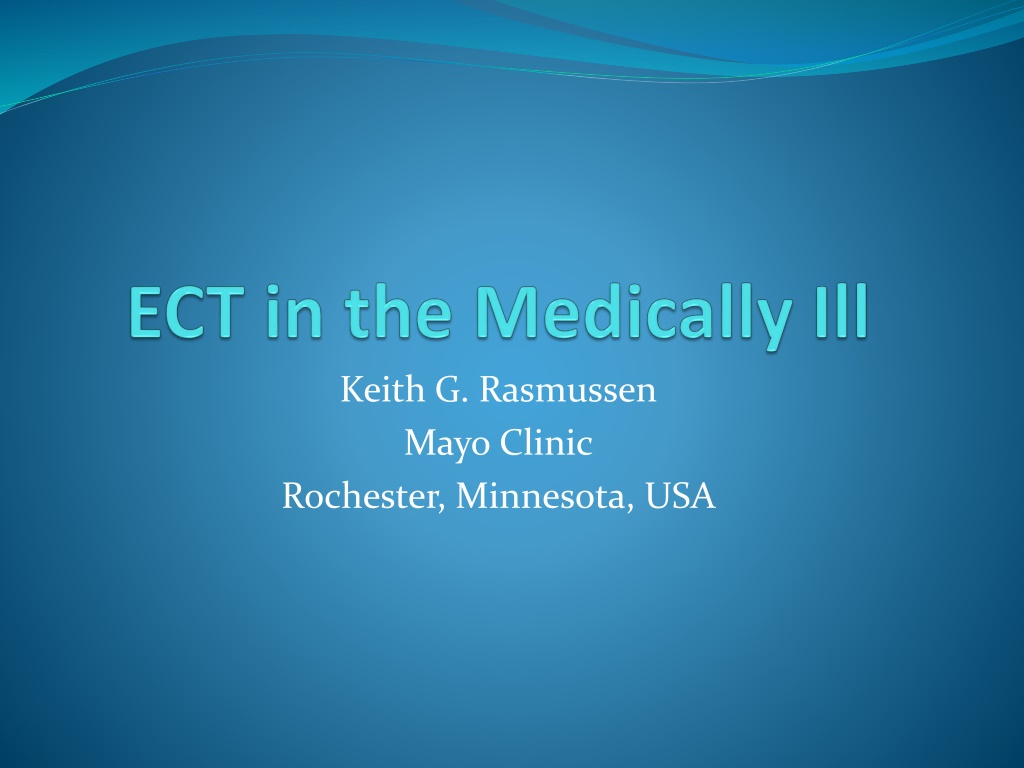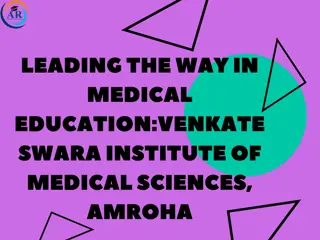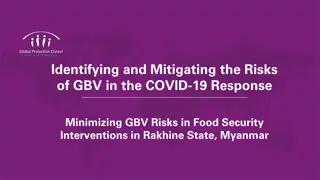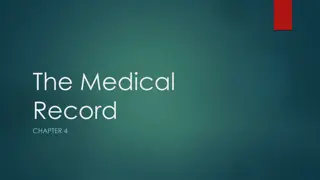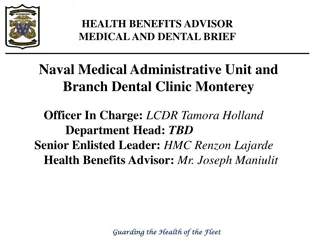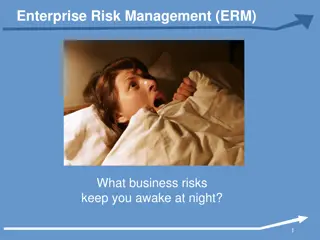Comprehensive Overview of Medical Risks and Strategies in ECT
In this detailed presentation, various aspects of medical risks associated with Electroconvulsive Therapy (ECT) are discussed, along with strategies to mitigate complications. Topics covered include the physiological effects of ECT on the cardiovascular, neurological, and endocrine systems, as well as morbidity and mortality rates. Strategies for risk reduction pre-ECT, focusing on thorough medical work-ups and patient stabilization, are also outlined. The role of cardiovascular disorders in ECT treatment is highlighted, emphasizing the need for careful consideration and management. Overall, the presentation provides valuable insights into understanding and addressing medical risks in ECT procedures.
Download Presentation

Please find below an Image/Link to download the presentation.
The content on the website is provided AS IS for your information and personal use only. It may not be sold, licensed, or shared on other websites without obtaining consent from the author. Download presentation by click this link. If you encounter any issues during the download, it is possible that the publisher has removed the file from their server.
E N D
Presentation Transcript
Keith G. Rasmussen Mayo Clinic Rochester, Minnesota, USA
Outline of Talk Review of medical risks associated with ECT Strategies to reduce risks of complications before starting ECT Strategies to reduce risks of complications in the ECT suite
Medical Risks of ECT Brief review of medical physiology of ECT focussing on cardiovascular system and brain Review of morbidity and mortality rates of ECT
Medical Physiology of ECT Cardiac: sharp increase in heart rate and blood pressure during the seizure, returning to normal usually within a few minutes of seizure termination. Neurologic: sharp increase in intracranial pressure and brain blood flow during the seizure with a drop after seizure termination. Endocrine: approximately 9% increase in blood glucose acutely with the seizure.
Morbidity and Mortality with ECT Morbidity includes major adverse cardiac events including myocardial infarction, stroke and respiratory complications, which are extremely rare We usually don t include side effects such as headache, nausea, muscle ache, or memory loss as morbidity as these are expected. Mortality is extremely rare; hard to pinpoint a precise figure as different centers treat different types of patients and have different levels of acute medical care should complications arise. Mortality is probably a function of a) medical acuity of patients treated;b) thoroughness of pre-ECT work up and medical stabilization; c) adequacy of monitoring and ventilation during the treatment; d) adequacy of back-up medical services like intensive care units
Risk Reduction Pre-ECT The pre-ECT medical work up The most important aspect of the pre-ECT medical work up is good medical history, review of systems, and physical examination and not specific tests like ECG, chest X ray, or blood tests. Things to do to mitigate complication risk: specialist consultations, tests (example, cardiac testing, head imaging) What to do with concomitant medications, psychiatric and non-psychiatric
Cardiovascular Disorders Congestive Heart Failure Coronary Artery Disease/Myocardial Infarction Arrhythmias Aneurysms Hypertension Heart Transplant Valvular Abnormalities Anticoagulation
Congestive Heart Failure Probably one of the riskiest medical conditions for ECT. The extra stress on the heart can precipitate an acute cardiac decompensation in such patients Make sure their cardiac status is maximally stabilized before starting ECT Administer all cardiac medications in the morning before treatments, including diuretics Ongoing daily assessment for cardiac status is very important, as changes may occur over time during ECT.
Coronary Artery Disease/Myocardial Infarction Very common If a patient has had a recent myocardial infarction, say the last 6 months, then consultation with a cardiologist prior to ECT is helpful Pre-ECT cardiac testing, such as stress echocardiography or adenosine sestamibi, may be indicated, but the usefulness of these tests specifically for ECT is not established. The stress on the heart during ECT treatments can be lessened with beta blocker medication
Arrhythmias Atrial fibrillation is the most common arrhythmia in ECT patients If a patient is known to have A-fib, then continue whatever medications they receive the mornings of ECT If a patient converts to A-fib during an ECT treatment, then cardiology consultation should be undertaken Extra rate control can be achieved with beta blockade during ECT treatments (eg, labetalol)
Aneurysms If a patient is known to have an aneurysm, then pre- treatment with a beta blocker should be undertaken during ECT treatments. Cerebral aneurysms would seem to be a high-risk, yet reports of rupture during ECT are non-existent.
Hypertension Hypertension of course is very common If a patient is about to be treated with ECT and the blood pressure seems high, then it can be reduced with a beta blocker or vasodilator such as labetalol or hydralazine, respectively Delaying ECT for prolonged periods in order to get hypertension under good control are probably unnecessary
Heart Transplant Theoretically, there should be a lesser risk of cardiac complications in such patients as the heart is denervated and thus not prone to the excess sympathetic stimulation during ECT.
Valvular Abnormalities There are scattered case reports of patients with aortic stenosis or mitral valve regurgitation given safe ECT, but one must assume a higher than usual risk of cardiac decompensation in such patients with ECT. With aortic stenosis in particular, there is a risk of precipitous drop in cardiac output with strong sympathetic stimulation with ECT but there are also risks of using beta blockers as well. It is important to obtain cardiologic consultation in patients with known valvular disease
Anticoagulation The usual indications for anticoagulation in ECT patients are atrial fibrillation, deep venous thrombosis, and valvular disease/replacement. Anticoagulation should be continued during ECT and monitored regularly to ensure therapeutic dosing A common problem is sub- or supra-therapeutic dosing and whether to cancel a treatment Generally, treatments should not be withheld just because of a somewhat low or high INR
Neurological Disorders Dementia Parkinson Disease Epilepsy Stroke/Cerebrovascular disease Brain Tumors Multiple Sclerosis
Dementia Elderly patients with depression and cognitive impairment are common Sometimes it is difficult to determine if such a patient has a neurodegenerative dementing syndrome in addition to depression, and one must await ECT outcomes with longitudinal follow up to arrive at a final diagnosis Should demented patients be treated always with unilateral ECT?
Parkinson Disease An older literature suggests that the movement disturbances associated with parkinsonism can improve with ECT It has been recommended that levodopa dosing be reduced, say cut in half, during ECT in anticipation of excessive cognitive impairment during ECT Risk of delirium and ECT-induced dyskinesias ECT has a pro-dopaminergic effect Use of unilateral electrode placement is probably a good idea, at least to start
Epilepsy Convulsive therapy got started when Meduna theorized a biological antagonism between seizures and psychosis It would seem counter-intuitive to give seizures to epileptics ECT does cause a progressive increase in seizure threshold, so may have anti-epileptic properties Not used for that purpose anymore May need to lower anti-epileptic drug doses if seizure induction is difficult
Stroke/Cerebrovascular disease Many case reports and case series attesting to successful and uneventful ECT in post-stroke patients After an acute stroke, one would want to wait a few months before commencing ECT if possible However, an occasional patient is so depressed that ECT is necessary Good blood pressure control is important, with use of beta blockade most common in the USA
Brain Tumors Meningiomas probably do not represent a high-risk situation, especially if there is no mass effect or edema Other brain tumors are extremely rare in patients considered for ECT (I ve never seen one) If one did contemplate ECT in a patient with a known intracranial tumor other than meningioma, collaboration with a neurosurgeon or neurologist to lessen the rise in intracranial pressure would be essential
Multiple Sclerosis Some evidence that if the MRI scan shows gadolinium enhancing lesions, risk of neurologic deterioration is greater This evidence is quite small, however Many case reports of safe and successful ECT in multiple sclerosis patients One would want to treat active lesions first with primary therapy (such as steroids) before considering ECT If patient is fulminantly ill, say in catatonic stupor, then waiting may not be possible
Other Medical Conditions Pregnancy Chronic obstructive pulmonary disease Diabetes mellitus
Pregnancy In the early phase, the risks seem to be possible teratogenic effects of anesthetic medications In the later phases, the risks are premature labor and placental abruption Non-invasive fetal monitoring is recommended Availability of obstetric/neonatal services is mandatory if doing ECT on a pregnant woman
Chronic obstructive pulmonary disease/Asthma Availability of personnel who are competent at ventilations is the key If a patient is prescribed inhalers, then taking those just prior to treatments probably helps the airway Close attention to respiratory sufficiency in the recovery room is essential I have not seen a patient taking theophylline in many years, but that drug can result in prolonged seizures during ECT and blood levels must be established as therapeutic
Diabetes Mellitus Very common in ECT patients, especially type II Checking blood sugar the morning of ECT treatments should be done (fingerstick) At Mayo, we also check after the treatment but this is not mandatory If the reading is too low, then we administer some dextrose IV fluids If too high, we either cancel the treatment or administer some insulin and wait for it to come down Half dosing of insuling prior to treatment, prompt treatment, then post-treatment give some juice and the remainder of the morning insulin dose
Summary Points ECT is exquisitely safe The best way to prevent complications is good pre- treatment assessment and stabilization of medical conditions Ongoing vigilance during the course of treatments Good communication among the various personnel involved Fancy, high cost tests have a secondary role
